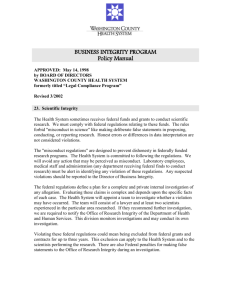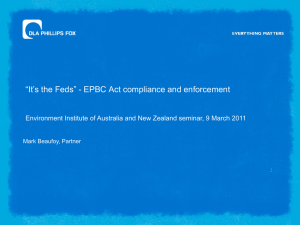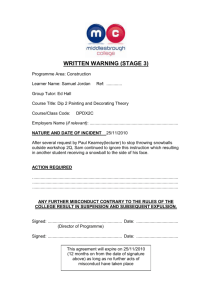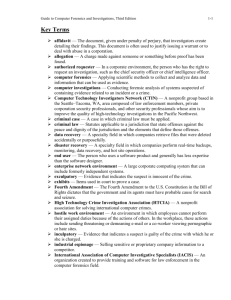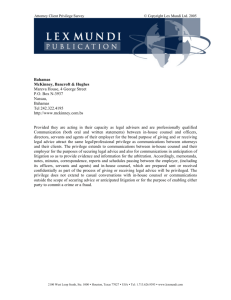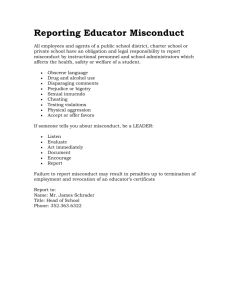confronting criminal liability in a post
advertisement
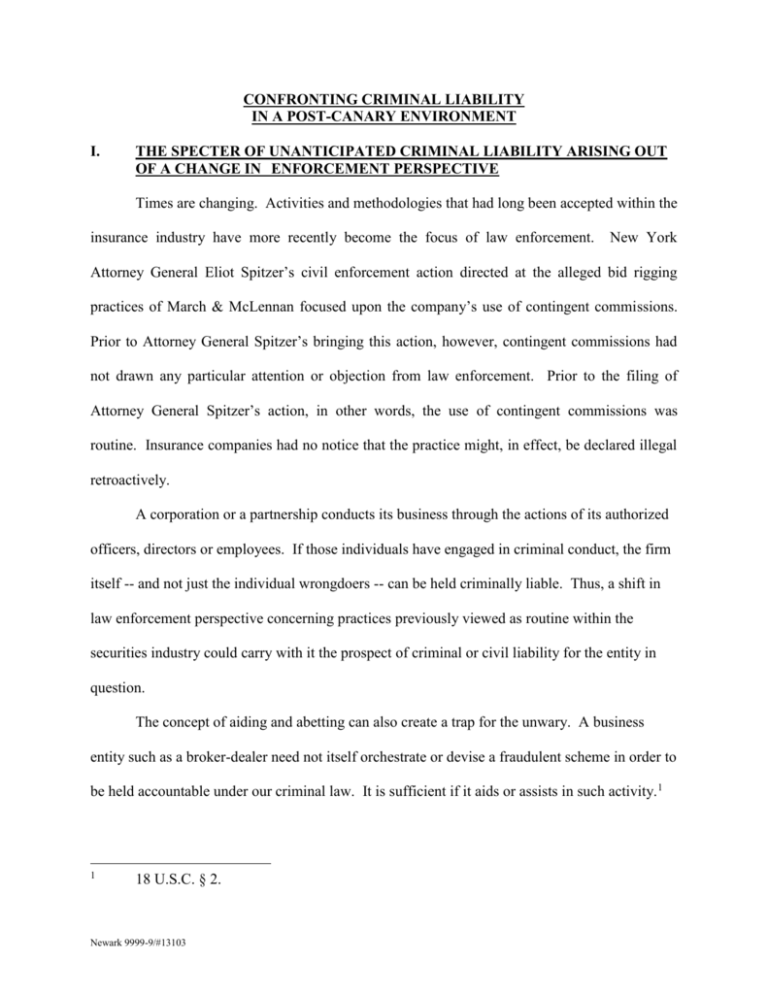
CONFRONTING CRIMINAL LIABILITY IN A POST-CANARY ENVIRONMENT I. THE SPECTER OF UNANTICIPATED CRIMINAL LIABILITY ARISING OUT OF A CHANGE IN ENFORCEMENT PERSPECTIVE Times are changing. Activities and methodologies that had long been accepted within the insurance industry have more recently become the focus of law enforcement. New York Attorney General Eliot Spitzer’s civil enforcement action directed at the alleged bid rigging practices of March & McLennan focused upon the company’s use of contingent commissions. Prior to Attorney General Spitzer’s bringing this action, however, contingent commissions had not drawn any particular attention or objection from law enforcement. Prior to the filing of Attorney General Spitzer’s action, in other words, the use of contingent commissions was routine. Insurance companies had no notice that the practice might, in effect, be declared illegal retroactively. A corporation or a partnership conducts its business through the actions of its authorized officers, directors or employees. If those individuals have engaged in criminal conduct, the firm itself -- and not just the individual wrongdoers -- can be held criminally liable. Thus, a shift in law enforcement perspective concerning practices previously viewed as routine within the securities industry could carry with it the prospect of criminal or civil liability for the entity in question. The concept of aiding and abetting can also create a trap for the unwary. A business entity such as a broker-dealer need not itself orchestrate or devise a fraudulent scheme in order to be held accountable under our criminal law. It is sufficient if it aids or assists in such activity. 1 1 18 U.S.C. § 2. Newark 9999-9/#13103 By way of example, investment banks have historically not been held responsible for their clients’ accounting procedures. Yet, as suggested in a recent Government Accounting Office report, investment banks who participated in complex financial transactions with Enron could be held liable under an aiding and abetting theory if, through their investment assistance, they facilitated Enron transactions that they knew would materially misstate Enron’s financial statements.2 Recent prosecutions of entities such as Arthur Andersen & Company may presage a new aggressiveness against business entities on the part of federal and state law enforcement. How, then, should an entity react when it learns that wrongdoing -- perhaps involving some activity long thought to be acceptable -- has occurred within its ranks? How can such an entity avoid becoming a defendant in a criminal prosecution or enforcement proceeding relating to such activity? II. RECENT GUIDELINES PROMULGATED IN CRIMINAL AND ENFORCEMENT ACTIONS. A. The Thompson Memorandum On January 20, 2003, then-Deputy Attorney General (“DAG”) Larry D. Thompson issued a memorandum to all United States Attorneys entitled “Principles of Federal Prosecution of Business Organizations” (“the Thompson Memorandum”).3 The Thompson Memorandum set forth nine principles that are to guide United States Attorneys in deciding whether to seek criminal charges against a business organization. The nine factors are as follows: 1. The nature and seriousness of the offense, including the risk of harm to the public, and applicable policies and priorities, if 2 GAO-03-511, a report to the Senate Committee on Banking, Housing and Urban Affairs and the House Committee on Financial Services, March 2003. 3 A copy of this memorandum is annexed as Exhibit A. Newark 9999-9/#13103 -2- any, governing the prosecution of corporations for particular categories of crime. 2. The pervasiveness of wrongdoing within the corporation, including the complicity in, or condonation of, the wrongdoing by corporate management. 3. The corporation’s history of similar conduct, including prior criminal, civil, and regulatory enforcement actions against it. 4. The corporation’s timely and voluntary disclosure of wrongdoing and its willingness to cooperate in the investigation of its agents, including, if necessary, the waiver of corporate attorneyclient and work product protection. 5. The existence and adequacy of the corporation’s compliance program. 6. The corporation’s remedial actions, including any efforts to implement an effective corporate compliance program or to improve an existing one, to replace responsible management, to discipline or terminate wrongdoers, to pay restitution, and to cooperate with the relevant government agencies. 7. Collateral consequences, including disproportionate harm to shareholders, pension holders and employees not proven personally culpable and impact on the public arising from the prosecution. 8. The adequacy of the prosecution of individuals responsible for the corporation’s malfeasance. 9. The adequacy of remedies such as civil or regulatory enforcement actions. The Thompson Memorandum indicates that, in making a prosecutive decision about a business entity, the Government will henceforth consider not only the seriousness of the offense and the entity’s prior track record, but also the entity’s conducting a prompt and timely selfinvestigation, its timely and voluntary disclosure of wrongdoing and its cooperation with any ongoing federal investigation. Such cooperation, the Thompson Memorandum further suggests, should often include a corporate decision to waive the attorney-client privilege and attorney work product protection in connection with its internal investigation of the wrongdoing. While Newark 9999-9/#13103 -3- declaring that the Department of Justice “does not … consider waiver of a corporation’s attorney-client and work product protection an absolute requirement,” the decision to so waive is “often critical in enabling the Government to evaluate the completeness of a corporation’s voluntary disclosure and cooperation.” (at 5). Thus, a business entity seeking to avoid criminal culpability may have to decide, among other things, whether to turn over to the Government all the information it has gathered internally about its employees’ wrongdoing, including the contents of all relevant communications with its attorneys. B. The Seaboard Case In October 2001, the SEC brought a cease and desist proceeding that exemplifies the application of principles like those subsequently set forth in the Thompson Memorandum. In the so-called Seaboard case, the SEC proceeded against the former controller of a public company’s subsidiary.4 This individual had caused the parent company’s books and records to be inaccurate and its periodic reports to be misstated and then covered up those facts. The SEC, however, took no action against the parent company. In so deciding, the SEC placed great emphasis on the company’s voluntary and complete cooperation with its investigation. Within a week of learning about the employee’s conduct, the SEC explained, the parent company had conducted a preliminary review, advised its full board of directors of the problem, hired an outside law firm to conduct a thorough inquiry, dismissed the responsible employees, and promptly thereafter made a full public disclosure of the situation. When the SEC commenced its investigation, the parent cooperated fully. As part of its cooperation, it waived all privileges relating to its internal investigation. 4 A copy of the SEC Release regarding the Seaboard case is annexed as Exhibit B. Newark 9999-9/#13103 -4- In announcing its decision, the SEC delineated the criteria for its future determinations on whether to forgo enforcement action against corporate entities: 1. What is the nature of the misconduct involved? Did it result from inadvertence, honest mistake, simple negligence, reckless or deliberate indifference to indicia of wrongful conduct, willful misconduct or unadorned venality? Were the company’s auditors misled? 2. How did the misconduct arise? Is it the result of pressure placed on employees to achieve specific results, or a tone of lawlessness set by those in control of the company? What compliance procedures were in place to prevent the misconduct now uncovered? Why did those procedures fail to stop or inhibit the wrongful conduct? 3. Where in the organization did the misconduct occur? How high up in the chain of command was knowledge of, or participation in, the misconduct? Did senior personnel participate in, or turn a blind eye toward, obvious indicia of misconduct? How systemic was the behavior? Is it symptomatic of the way the entity does business, or was it isolated? 4. How long did the misconduct last? Was it a one-quarter, or one-time, event, or did it last several years? In the case of a public company, did the misconduct occur before the company went public? Did it facilitate the company’s ability to go public? 5. How much harm has the misconduct inflicted upon investors and other corporate constituencies? Did the share price of the company’s stock drop significantly upon its discovery and disclosure? 6. How was the misconduct detected and who uncovered it? 7. How long after discovery of the misconduct did it take to implement an effective response? 8. What steps did the company take upon learning of the misconduct? Did the company immediately stop the misconduct? Are persons responsible for any misconduct still with the company? If so, are they still in the same positions? Did the company promptly, completely and effectively disclose the existence of the misconduct to the public, to regulators and to selfregulators? Did the company cooperate completely with appropriate regulatory and law enforcement bodies? Did the Newark 9999-9/#13103 -5- company identify what additional related misconduct is likely to have occurred? Did the company take steps to identify the extent of damage to investors and other corporate constituencies? Did the company appropriately recompense those adversely affected by the conduct? 9. What processes did the company follow to resolve many of these issues and ferret out necessary information? Were the Audit Committee and the Board of Directors fully informed? If so, when? 10. Did the company commit to learn the truth, fully and expeditiously? Did it do a thorough review of the nature, extent, origins and consequences of the conduct and related behavior? Did management, the Board or committees consisting solely of outside directors oversee the review? Did company employees or outside persons perform the review? If outside persons, had they done other work for the company? Where the review was conducted by outside counsel, had management previously engaged such counsel? Were scope limitations placed on the review? If so, what were they? 11. Did the company promptly make available to our staff the results of its review and provide sufficient documentation reflecting its response to the situation? Did the company identify possible violative conduct and evidence with sufficient precision to facilitate prompt enforcement actions against those who violated the law? Did the company produce a thorough and probing written report detailing the findings of its review? Did the company voluntarily disclose information our staff did not directly request and otherwise might not have uncovered? Did the company ask its employees to cooperate with our staff and make all reasonable efforts to secure such cooperation? 12. What assurances are there that the conduct is unlikely to recur? Did the company adopt and ensure enforcement of new and more effective internal controls and procedures designed to prevent a recurrence of the misconduct? Did the company provide our staff with sufficient information for it to evaluate the company’s measures to correct the situation and ensure that the conduct does not recur? 13. Is the company the same company in which the misconduct occurred, or has it changed through a merger or bankruptcy reorganization? Newark 9999-9/#13103 -6- For the SEC, too, prompt and thorough self-investigation and full cooperation with investigating authorities are key factors in its determination of whether to bring an enforcement proceeding against an otherwise-culpable business entity. In a footnote within its Release, the SEC further suggested full cooperation may in some cases entail a waiver of the attorney-client privilege. C. The Federal Sentencing Guidelines By the time a United States District Court schedules a sentencing date for a business organization, it is, undoubtedly, a little late for that organization to be musing about how it can avoid criminal liability in a given matter. Nevertheless, recent amendments to the federal Sentencing Guidelines and the Application Notes thereto demonstrate the increasing importance that Government prosecutors can be expected to place on a corporation’s waiver of the attorneyclient privilege as part of its cooperation. And cooperation is an important factor in determining a corporation’s sentence.5 USSG § 8C2.5 sets for the criteria for developing a convicted organization’s “culpability score” for purposes of sentencing. Subsection (g), entitled “Self Reporting, Cooperation, and Acceptance of Responsibility,” provides as follows: If more than one applies, use the greatest: (1) 5 If the organization (A) prior to an imminent threat of disclosure or government investigation; and (B) within a reasonably prompt time after becoming aware of the offense, reported the offense to appropriate governmental authorities, fully cooperated in the investigation, and clearly demonstrated recognition and affirmative The philosophy underlying the Sentencing Guidelines in this regard will not change, even though the Guidelines themselves are now discretionary and not mandatory. Newark 9999-9/#13103 -7- acceptance of responsibility for its criminal conduct, subtract 5 points; or (2) If the organization fully cooperated in the investigation and clearly demonstrated recognition and affirmative acceptance of responsibility for its criminal conduct, subtract 2 points; or (3) If the organization clearly demonstrated recognition and affirmative acceptance of responsibility for its criminal conduct, subtract 1 point. In newly-revised Application Note 12 for this section, the United States Sentencing Commission declares that, to qualify for a reduction, the cooperation “must be both timely and thorough.” To be timely, the Commission says, the proffered cooperation “must begin essentially at the same time as the organization is officially notified of a criminal investigation.” To be thorough, the cooperation should entail “the disclosure of all pertinent information known by the organization.” III. INTERNAL INVESTIGATIONS AND THE ATTORNEY-CLIENT PRIVILEGE. A. The Role of In-House Counsel It goes almost without saying that any business entity can ill afford to ignore a situation where a change in law enforcement perspective suggests a lapse in the company’s compliance procedures. An internal inquiry must be conducted. Prompt initiation of an internal investigation is particularly important in light of Patriot Act regulations, which impose on many companies a 30-day deadline for filing a Suspicious Activity Report (“SAR”) with the Financial Crimes Enforcement Network. A SAR is required upon discovery of many types of illegality. An internal investigation promptly upon discovery of a problem would seem to be a necessary prerequisite for complying with the requirement for filing a SAR. The SEC requires a broker-dealer to carry out an internal investigation once credible evidence of wrongdoing surfaces: Newark 9999-9/#13103 -8- Red flags and suggestions of irregularities demand inquiry as well as adequate follow-up and review. When indications of impropriety reach the attention of those in authority, they must act decisively to detect and prevent violations of the federal securities laws.6 At the outset of such an inquiry, though, it should not be presumed that the entity will automatically decide later to waive the benefit of the attorney-client privilege. Thus, at least initially, the entity should take steps to ensure that the privilege will be available to it should it so desire. This means that an attorney should lead the investigation. It may not be necessary to retain outside counsel immediately. But if the investigation is initially conducted by in-house counsel, it must be clear to all concerned -- including but not limited to employees who are questioned during the inquiry -- that the attorney is acting as a lawyer, not as a business advisor. Consultations with an attorney not acting in a legal capacity are not privileged.7 Employees must be advised that the in-house counsel is acting in his or her capacity as attorney for the company. At the same time, the employees should be specifically advised that in-house counsel is not their attorney, and that, therefore, a decision about whether to waive the attorney-client privilege in connection with the interviews is within the sole province of the company. C. Outside Counsel 6 In re Kirkpatrick, Pettis Smith, Polian, Inc., 2003 WL 22514507 (Nov. 5, 2003), SEC Release No. 34-48748, quoting from In re Edward Kantor, 51 S.E.C. 440, 447 (May 20, 1993). 7 See, e.g., Status Time Corp. v. Sharp Electronics Corp., 95 F.R.D. 27, 29-31 (S.D.N.Y. 1982); In re: Arthur Treacher’s Franchisee Litigation, 92 F.R.D. 429, 435-436 (E.D.P.A. 1981); SEC v. Gulf and Western Industries, Inc., 518 F. Supp. 675, 683 (D.D.C. 1981). Newark 9999-9/#13103 -9- Both the SEC in its Seaboard proceeding and the Thompson Memorandum discuss with favor the concept of employing outside counsel to conduct an independent investigation. Certainly, utilizing outside counsel and giving that counsel free rein to conduct an appropriate inquiry carries with it a more impressive cachet than having in-house counsel do the job. More impressive cachet, of course, comes at a higher financial price; such investigations, done properly, are expensive. But a company that is under suspicion because of changing industry mores may find that expenditure to be a good long-term investment. Authorizing an investigation by outside counsel shortly after learning about the existence of an internal problem is an indication that the company in question is serious about enforcing its own compliance rules and ethical standards. When a board of directors retains an outside law firm to conduct such an investigation, it does so for the benefit of the entity, not any individual or individuals within the entity. It is the entity that retains the attorney-client privilege with regard to the investigation. Once again, individual employees who are interviewed should be advised that the lawyer in question is the company’s lawyer, not theirs. Similarly, they should be told that the company alone can decide to waive the attorney-client privilege regarding their interview. The ability of the company to waive the attorney-client privilege at its option could create a real conflict between the company and certain of its employees in connection with the investigation. If the outside counsel is to conduct an appropriate and thorough inquiry, it is critical that all employees cooperate fully with the undertaking. Often, wrongdoing within a corporation is orchestrated by one or more members of upper management. Those upper management types effectively coerce mid-level employees into compliance with their directives. Were a United States Attorney thereafter to conduct an Newark 9999-9/#13103 - 10 - investigation, the testimony of those mid-level employees against upper management is often critical to its success. Mid-level employees can often, therefore, bargain with the Government for immunity in return for their cooperation. But an attorney or law firm acting on behalf of the entity’s Board of Directors is powerless to grant immunity. The Government does not like to bestow immunity freely, because such a grant adversely impacts the credibility of the recipient. If the Government were to receive from outside counsel the reports of interviews conducted during the latter’s investigation, it may derive sufficient evidence from those interviews to prosecute the mid-level employees and coerce their testimony within the context of a plea agreement, without providing immunity. For mid-level employees, then, the decision to cooperate with an investigation by the company’s outside counsel could be very costly. II. WAIVER OF THE ATTORNEY-CLIENT PRIVILEGE A company’s agreement to waive the attorney-client privilege is cited both in Seaboard and in DAG Thompson’s memorandum as a factor in a non-prosecution decision. Agreeing to waive the privilege, however, is not as cut-and-dried as it might appear. For one thing, a partial waiver is unlikely to be sufficient. If the attorney-client privilege is waived, all information transmitted between lawyer and client -- including all recommendations made to the board of directors -- is potentially available to the Government. Perhaps more importantly, in certain jurisdictions a waiver of the privilege cannot be limited to the Government entity conducting a criminal or enforcement investigation.8 Once the privilege is waived as to the SEC, for example, it may be impossible for the waiving company to 8 See, e.g., United States v. Massachusetts Institute of Technology, 129 F.3d 681 (1st Cir. 1997); Westinghouse Electric Corp. v. Republic of the Philippines, 951 F.2d 1414 (3d Cir. 1991). Newark 9999-9/#13103 - 11 - shield its internal investigation or its advice of counsel from subsequent third parties who may seek to sue the company civilly. If the privilege is waived as to the Government, in other words, the company might find itself in a position where it must turn over to civil litigants against it the fruits of its entire internal investigation. The potential consequences of a waiver in connection with subsequent civil litigation are heavy, and must be considered in connection with any decision to waive the privilege. For a waiver of the attorney-client privilege to be of most help to the Government, moreover, it should be given at the outset of the criminal or enforcement investigation. That is the time, however, when the Government would be least likely to make any assurances to the entity as to whether it will be prosecuted. By waiving the privilege, the entity could be handing the Government a case against it on a silver platter, without any meaningful expectation about whether the information so furnished will be used against it. Any decision to waive the attorney-client privilege regarding an entity’s internal investigation, then, is fraught with risk. Yet, such a waiver is perhaps the clearest and most meaningful indication that the entity is doing everything it can to cooperate with the Government and obtain the maximum benefit available to it for that cooperation. Newark 9999-9/#13103 - 12 -
